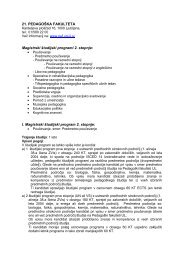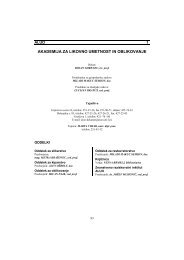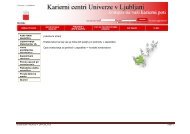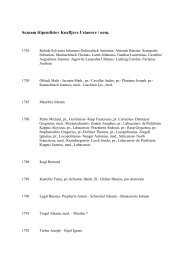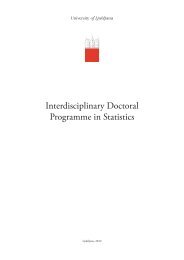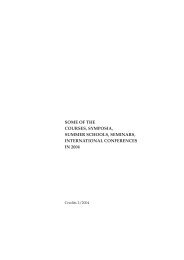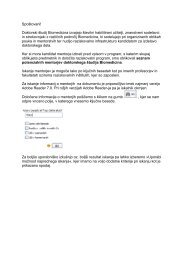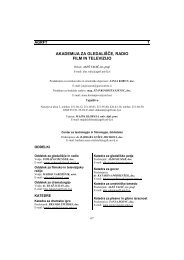Medicinska fakulteta Univerze v Ljubljani 1919–1945 - Univerza v ...
Medicinska fakulteta Univerze v Ljubljani 1919–1945 - Univerza v ...
Medicinska fakulteta Univerze v Ljubljani 1919–1945 - Univerza v ...
You also want an ePaper? Increase the reach of your titles
YUMPU automatically turns print PDFs into web optimized ePapers that Google loves.
the Order of the Brothers of Mercy regarding the ward for special<br />
patients (Abteilung für besondere Kranke) from 1808, however,<br />
this ward did not have any connection to Gradišek’s homeopathic<br />
system� It is interesting to note that the other Austrian lyceums<br />
did not have such an institute, which again shows the aspirations<br />
of Ljubljana in regard to medical-surgical studies, namely for the<br />
lyceum there to grow into a genuine university-level study� In his<br />
desire to ensure selective admission to this ward, the director of<br />
Medical-Surgical Studies, Dr� Karl Bernard Kogel, laid down the<br />
condition that patients from rural areas could also be admitted,<br />
that admission was only possible with an admission slip and that<br />
the professor and assistant could select patients suitable for the<br />
ward from among the city’s poor people� By sending a special<br />
circular, he notified the district authorities that they should send<br />
educational and rare cases to the hospital, whereby he especially<br />
highlighted cases of “gunshot wounds, head trauma, complicated<br />
fractures, dislocations, burns, ulcers, fistulae, syphilis, benign<br />
and malign tumours, gallstones, hernias and hydrocoeles”� He<br />
established an emergency clinic�<br />
In the mid twenties, the city municipality built an annex to the<br />
hospital in Ajdovščina that housed a hall for dissection and an<br />
anatomy-pathology cabinet, which was located in the lyceum<br />
building up until then�<br />
The 1833 study reform allowed the medical-surgical studies at the<br />
Ljubljana Lyceum to reach their pinnacle� In the official acts at<br />
the time, the individual teachers at the lyceum were appointed<br />
to the position of professor� The Chair of Theoretical Medicine<br />
was founded and represented the first step towards pathology<br />
becoming a required course� By splitting the Chair into the<br />
theoretical and practical parts, the curriculum at the time already<br />
came closer to the study system of today: instruction of pathological<br />
anatomy and experimental pathology� The unnecessary<br />
division of surgery into the theoretical and practical parts was<br />
abolished� The most characteristic new feature of the reform<br />
was the Chair for Preparatory Sciences – an important supplementation<br />
of the theoretical education of future surgeons and<br />
an important teaching supplementation for other courses� Even<br />
more so because the four grades of the gymnasium did not offer<br />
future candidates the necessary breadth of ancillary knowledge�<br />
What is most important, however, is that the four grades did not<br />
provide the students with the ability to ascertain whether they<br />
were even suitable for this profession� As already mentioned, the<br />
syllabus of the then six-grade gymnasium did not comprise any<br />
natural science courses� Even in this respect, the Ljubljana Lyceum<br />
was an exception when compared to those in other provinces� The<br />
mentioned in-the-field instruction of botany within the scope<br />
of the study of philosophy at the Ljubljana Lyceum that was<br />
associated with the botanical gardens enabled both surgeons and<br />
the learners of medical-surgical studies to gain some botanical<br />
knowledge� The importance of the botanical gardens, which<br />
were – as already mentioned – administered by those in charge of<br />
101<br />
the study of philosophy, was well known to those at the medicalsurgical<br />
studies� Consequently, after Prof� Franc Hladnik retired<br />
and the study of philosophy did not have a suitable person for<br />
the job, the management of the gardens along the Ižanska cesta<br />
road was taken over by Dr� Jan Nepomuk Biatzowsky, Professor<br />
of Preparatory Sciences, which also included botany, at medicalsurgical<br />
studies� This ensured the continuity in a professional<br />
sense and in terms of administration�<br />
The instruction in obstetrics now lasted two months� The<br />
theoretical portion of the course was provided in Slovenian in<br />
the morning and in German in the afternoon, while the clinical<br />
portion associated with practical exercises was provided at the<br />
maternity birthing beds at the maternity hospital�<br />
Since the thirties, lectures on first aid in the event of clinical death<br />
and aid in emergency life-threatening situations were available to<br />
anyone on Sundays and holidays�<br />
In the forties, extraordinary lectures on special pathology and<br />
therapy of childhood diseases were given three times a week<br />
during the winter semester, namely on Mondays, Wednesdays and<br />
Fridays, while practical exercise performed at the child’s bed were<br />
provided each afternoon at the maternity hospital�<br />
IV<br />
In accordance with the curriculum of medical-surgical studies<br />
from 1810, studies proceeded as follows in Ljubljana at the end<br />
of the twenties:<br />
First year<br />
First semester<br />
a) Introduction to the Study of Surgery as an Encyclopaedic<br />
Overview with Anatomy, from 2 pm to 3 pm<br />
b) Introduction to the Study of Surgery and Theoretical Surgery,<br />
i�e� General and Special Pathology of External Diseases, from<br />
3 pm to 4 pm<br />
c) Physiology, General Pathology of Internal Diseases, from 4 pm<br />
to 5 pm<br />
d) Theoretical and Practical Obstetrics for Midwifes, from 7 am<br />
to 8 am<br />
Second semester<br />
a) Anatomy, from 2 pm to 3 pm<br />
b) Theoretical Surgery, from 3 pm to 4 pm<br />
c) Materia Medica et Chirurgica, Dietetics and the Introduction<br />
to Prescription Writing, from 4 pm to 5 pm<br />
d) Theoretical and Practical Obstetrics for Midwifes, from 7 am<br />
to 8 am<br />
e) Continuation of Theoretical Surgery, i�e� General and Special<br />
Pathology of External Diseases, from June to the end of the<br />
academic year: Instruction on Surgical Wound Dressing and<br />
Instruments, from 3 pm to 4 pm



